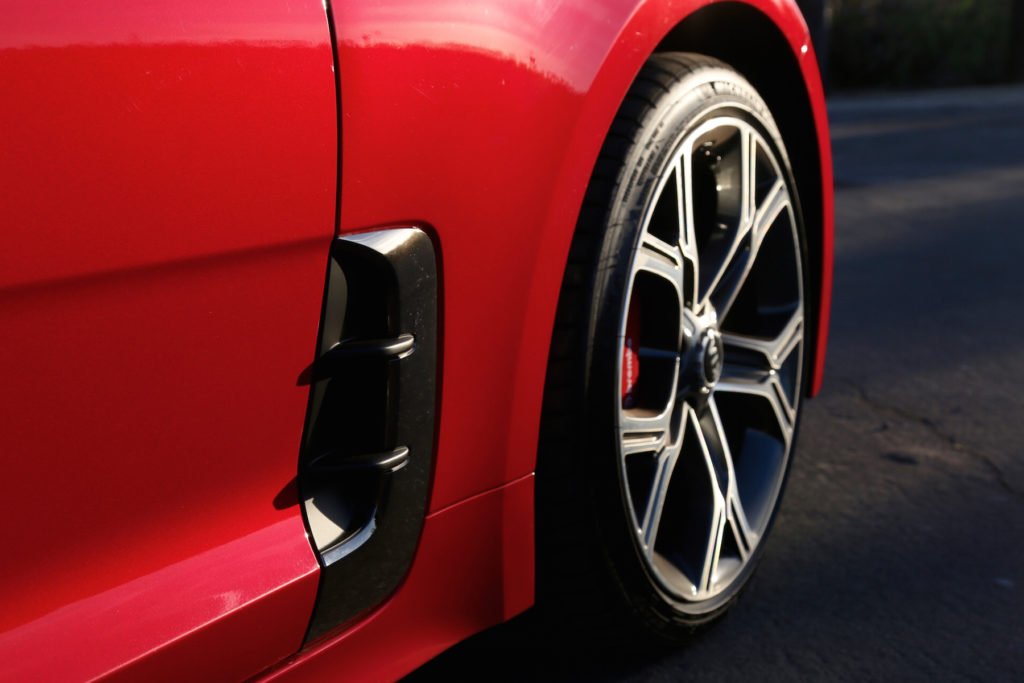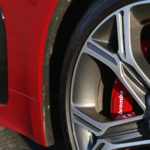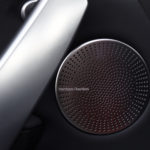Supercars, military tanks, helicopters, and flying saucers: These are just a few of the transportation devices that would receive less attention that the 2018 Kia Stinger GT. During our week with Kia’s first-ever sport sedan, no fewer than 20 different people paused their lives to inspect the Korean-made five-door. Our favorite comment (and we suspect Kia would agree) came from a middle-aged male with mild slackjaw. “Sheesh that’s a beautiful car,” he remarked. “I was going to buy my wife a new Lexus, but maybe I should get her one of these instead.”
The Stinger GT is Kia’s most significant model to date and a promised turning point for a brand best known for economy cars. Styling, technology, and performance will trickle down from the Stinger to all Kia models, but we don’t have to wait until some future date to get excited. The Stinger GT is handsome, potent, and luxurious in all the same ways as its German-made rivals, BMW’s 440i Gran Coupe ($49,700) and Audi’s A5 Sportback Prestige ($50,200). Our test vehicle is a top-of-the-line GT2 trim, retailing for $49,200 (plus destination and handling). Entry-level Stingers with a more modest turbocharged four-cylinder start at just $31,900.
Without further ado, let’s dive into our full 2018 Kia Stinger GT review.
Luxury and Technology
Performance figures make compelling headlines, but for Kia to actually steal buyers away from BMW or Audi, the Stinger needs premium amenities. To that end, the Stinger GT2 package includes a Nappa leather, heated and ventilated seats, dual-zone automatic climate control, an 8.0-inch touchscreen display with voice commands, Apple CarPlay, and Android Auto, a 15-speaker Harmon Kardon sound system, a full suite of driver aids, a head-up display, and a 7.0-inch digital driver monitor. We are hard pressed to think of anything the BMW 4 Series GC or the Audi A5 Sportback offer that the Stinger GT does not.
Special focus must be given to the Stinger’s available sound system. Harmon Kardon is renowned for its quality electronics, but the Stinger’s 720-watt, 12-channel unit is a new benchmark. Few vehicles — at any price point — can match the sound quality, range, and balance of the system. One trick to the Stinger’s system is a subwoofer placed beneath each front seat. For heavy bass music, the “butt-subs” add a new dimension to the listening experience. Clari-Fi works to restore audio details lost in digitally compressed music, while Quantum Logic’s surround sound is tailored to the Stinger’s hatchbacked interior for maximum impact. Perhaps the most flattering thing we can say about the system is that it reminds us of a high quality pair of headphones.
Another win for the Stinger GT is its comprehensive driver assistance suite. While both the 4 Series GC and A5 Sportback offer driver aids, they come at a hefty premium ($2,200 for the BMW and $1800 for the Audi) and are do not match the range of features included in the Stinger. Included in the Stinger GT2 package is full speed adaptive cruise control, a backup camera with parking grid lines, front and rear parking sensors, blind spot warning with lane change assist, rear cross traffic alert, forward collision avoidance with pedestrian protection, lane departure warning, lane keeping assist, and a driver attention monitor. At present, there isn’t a broader ranging suite of driver aids on the market – again, at any price point.
An upgrade to the standard 7.0-inch display, the 8.0-inch infotainment is neither innovative nor outdated. Resolution and response time is acceptable, though notably behind Audi and BMW’s systems. To its credit, the Stinger’s module is effortless to navigate and includes Apple CarPlay and Android Auto (additional cost or unavailable options on the A5 and 4 Series). Another niggle on our part is with the infotainment’s housing. Obstructively large, we wish the screen could at least stow within the dash when the vehicle is off.
The Stinger GT’s conventional luxury is as impressive as its technology. Available Nappa leather seats with heating and ventilation offer the right blend of ergonomic support and relaxed comfort. Even after a long commute, these seats leave you feeling fresh. Fit and finish along the dash, center console, and door inserts is of similar quality to the A5 and 4 Series, though a few trim pieces feel cheaper. Cargo volume with the rear seats in place is a class-leading 23.3 cu. ft. and only the BMW 4 Series Gran Coupe has more total volume with the rear seats folded (45.9 cu. ft. to the Stinger’s 40.9 cu. ft.). Passenger volume is excellent as well, giving tall riders ample legroom and sufficient headroom. An SUV will still offer more hauling options, but the five-door shape is still more practical than a traditional sedan.
The Drive
On the surface, the Kia Stinger GT is a simple car: rear-drive, front-engine, automatic transmission. The trick to a great sport sedan, however, is the quality and congruity of these components. Kia’s first attempt at constructing a performance car should be a learning exercise. “We got these things right, but these things need work for the next project.” Instead, the Stinger GT feels like Kia’s purpose has always been to build this class of sporting vehicle.
The Stinger GT borrows its 3.3-liter twin-turbocharged V6 from the Genesis G90, delivering 365 horsepower and 376 pound-feet of torque via a house-made eight-speed automatic transmission. Rear wheel drive is standard, but all-wheel drive is available on all Stinger trims. Kia quotes a 0 to 60 mph sprint of 4.9 seconds and a top speed of 167 mph. By comparison, the 320-hp BMW 440i Gran Coupe is 0.1 seconds quicker to 60 mph and the 252-hp A5 Sportback is far behind at 5.7 seconds. Both the BMW and Audi are electronically limited to a top speed of 155 mph. While the Stinger GT’s output and performance figures are weighty, we think Kia may be sandbagging. Independent sources have clocked the GT at much quicker acceleration bursts, and our own butts tell us the GT is faster and more powerful than its figures suggest. Sadly, the exhaust music from the car’s quad-port system is more whisper than roar.
The Stinger’s biggest dynamic hurdle to effective competition with the 4 Series and A5 is its steering and handling. BMW is among the most consistently praised brands when it comes to precision handling, and Audi’s Quattro all-wheel drive system is equally legendary. Kia, with zero performance reputation, must prove the Stinger GT is in the right classroom. No problem. The GT is so dialed in, we swear the car can read minds. Turn the drive mode dial to Sport, find your nearest curvy road, and prepare to giggle like a child. Kia’s electronically assisted rack is perfectly weighted and affords ample feedback as the car’s nimble chassis and burly Brembos encourage our boldest maneuvers. This is no poseur; it’s the real deal.
If there’s any drawback to all this performance, it’s the GT’s meager fuel economy. Both rear and all-wheel drive models return 25 highway, 19 city, and 21 combined mpg. By comparison, the 440i GC notches 32 highway, 21 city, and 25 combined mpg, and the A5 Sportback Quattro triumphs with 34 highway, 24 city, and 27 combined mpg.
The Verdict
The 2018 Kia Stinger GT is one of the best cars we’ve driven this year, and perhaps the most surprising. We expected Kia to pull out all the stops on this one, but we just didn’t expect its best would be this good. Bucking the trend of SUV obsession, Kia embraces the dynamic strengths of a low-slung sedan for those who are still willing to stand out. The result is a playful yet sophisticated product that is precisely what the stale luxury market needs.
Kia may not have the luxury cred of BMW or Audi, but it more than makes up for lost time with a kick-ass product. The Stinger GT is stylish, fun, and upscale. What more do you need?



















